Madagascar’s Endemic Plants and Flowers
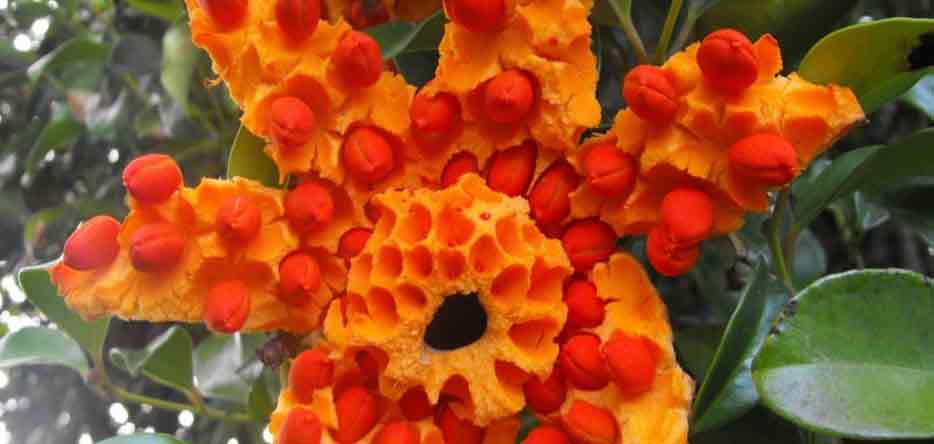
Madagascar is considered one of the most unique places on earth in terms of diversity and the uniqueness of its flora. More than 10,000 native species of plants have been identified, of which around 90% are endemic and only found in the country. However, many are critically endangered. Here’s everything you need to know.
Za Baobab (Andasonia Za Baill.)
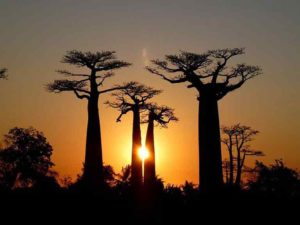 Anyone who plans to come to Madagascar must make sure they see the famous baobab. Seven out of nine species of the tree are found in Madagascar, and six of those are endemic to the island. This tree with a wide base which narrows towards the top grows to be between 10 – 40 meters (33 – 131 feet) tall and 6 meters (20 feet) wide. The Za Baobab is found from Andohahela and the Mandrare River in the south-west through southern and western Madagascar, to the Boina region and the Sambirano River Bassin. Some are considered sacred by local people and are surrounded by myth and legend.
Anyone who plans to come to Madagascar must make sure they see the famous baobab. Seven out of nine species of the tree are found in Madagascar, and six of those are endemic to the island. This tree with a wide base which narrows towards the top grows to be between 10 – 40 meters (33 – 131 feet) tall and 6 meters (20 feet) wide. The Za Baobab is found from Andohahela and the Mandrare River in the south-west through southern and western Madagascar, to the Boina region and the Sambirano River Bassin. Some are considered sacred by local people and are surrounded by myth and legend.
Bismarck palm (Bismarckia nobilis)
 Locally known as “satrana”, this plant is important in the north-west of Madagascar where it’s used for making planks or partition walls. The leaves of this palm are used for roofing and basketry and the pith is eaten as a slightly bitter sago. This plant is endemic to Madagascar but widespread across the north and west of the island. The species is identified as critically endangered because of loss of habitat due to agricultural and mining activities and increasing fire frequency.
Locally known as “satrana”, this plant is important in the north-west of Madagascar where it’s used for making planks or partition walls. The leaves of this palm are used for roofing and basketry and the pith is eaten as a slightly bitter sago. This plant is endemic to Madagascar but widespread across the north and west of the island. The species is identified as critically endangered because of loss of habitat due to agricultural and mining activities and increasing fire frequency.
Tapia (Uapaca bojeri Baill.)
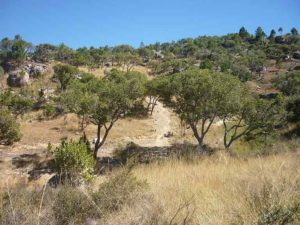 Locally known as “voampaka” or “voantapia” (fruit of tapia), “hazondandy” (wild silk tree) by the Betsileo people, and “voantapia” or “tapia” by the Merina people, the tapia is a sweet fruit that is commonly found in markets. Tapia forests are located in the highlands of Madagascar, mainly in the districts of Arivonimamo and Miarinarivo, between the districts of Antsirabe and Ambositra, and in the Isalo, near Ranohira. The tapia forests are also home to the rarest “borocera”, a wild silk worm used for spinning and artisanal weaving.
Locally known as “voampaka” or “voantapia” (fruit of tapia), “hazondandy” (wild silk tree) by the Betsileo people, and “voantapia” or “tapia” by the Merina people, the tapia is a sweet fruit that is commonly found in markets. Tapia forests are located in the highlands of Madagascar, mainly in the districts of Arivonimamo and Miarinarivo, between the districts of Antsirabe and Ambositra, and in the Isalo, near Ranohira. The tapia forests are also home to the rarest “borocera”, a wild silk worm used for spinning and artisanal weaving.
Madagascar banana tree (Ensete perrieri Cheesman)
Madagascar’s banana variety is expected to be the saviour of the world’s bananas that are threatened by a deadly fungal disease. Endemic to western Madagascar and found only in certain localities, this species has only five known mature individuals that need to be saved. It grows in a dry, tropical stony forest and is globally assessed as critically endangered. It’s a relative of and a potential gene donor to the crop banana.
Tahina palm (Tahina spectabilis)
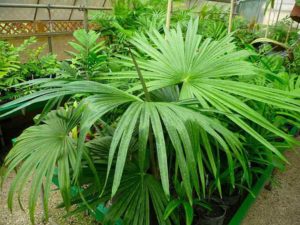 Only found in the nothwest of Madagascar, in the locality of Analalava, and assessed as “in extinction” (UICN 2008), this endemic species is in conservation in the Mahajanga Reniala Park. It grows in seasonally flooded land at the foot of a limestone hill. Also known as the “suicide palm”, it can also be found in the gently rolling hills and flatlands of the region. As a rare species, it is a highly prized plant but is greatly threatened by bushfire and livestock grazing.
Only found in the nothwest of Madagascar, in the locality of Analalava, and assessed as “in extinction” (UICN 2008), this endemic species is in conservation in the Mahajanga Reniala Park. It grows in seasonally flooded land at the foot of a limestone hill. Also known as the “suicide palm”, it can also be found in the gently rolling hills and flatlands of the region. As a rare species, it is a highly prized plant but is greatly threatened by bushfire and livestock grazing.
Octopus trees (Didierea madagascariensis Baill.)
 Endemic to the arid south west of Madagascar, the octopus tree grows in the spiny dry forests that contain the highest percentage of endemic plant species in the country (45% of the genera and 95% of the species existing nowhere else on earth). They are thorny, slightly succulent, deciduous shrubs or trees whose leaves grow in clusters on sparsely branched trunks.
Endemic to the arid south west of Madagascar, the octopus tree grows in the spiny dry forests that contain the highest percentage of endemic plant species in the country (45% of the genera and 95% of the species existing nowhere else on earth). They are thorny, slightly succulent, deciduous shrubs or trees whose leaves grow in clusters on sparsely branched trunks.
The Madagascar periwinkle (Catharanthus roseus)
Although it’s found commonly in any garden, this plant is a valuable natural product. It seems that it has been used to devise a cancer prevention drug developed in the 1950s and also has anti-diabetic properties. Its attractive white or pink flowers have made it a popular ornamental plant in homes across the world. Its relatively high tolerance of environmental changes have enabled the species to spread throughout many parts of the world.
Darwin’s orchid (Angraecum sesquipedale)

Of Madagascar’s 10,000 to 12,000 vascular plants, roughly 1 in 10 are orchids, most of which are endemic. This wild orchid with a spectacular six-pointed white star is one of them. It grows in coastal regions and has strange characteristics like the flower’s exceedingly long nectar spur. Charles Darwin obsessed with orchids’ pollination and predicted that this flower would be pollinated by a moth with an unusually long proboscis (his prediction turned out to be accurate more than 40 years later). The species is assessed as endangered.
Beautiful orchids of Madagascar
Orchids of Madagascar, with over 1000 species and 80% endemic, are queens flowers thanks to its legendary beauty. The Great Island offers the greatest diversity in the world. It is these beautiful plants, desired by their beauty, famous for their virtues. Nowadays, the island of Madagascar is still a sanctuary of endemic species.
The orchid family Orchidaceae, characterized by its flowering 3 petals, its beautiful forms and extraordinary colors. Most of the species of orchids from Madagascar will develop inside dry or wet forests. The abundance of orchids on the east coast of the island is not surprenante.Les orchids are often attached to other plants to grow (epiphytes). Being present on the island for thousands of years, orchids knew developed survival strategies, thanks in part to a harmonious relationship with wildlife such as butterflies, the birds, the ants, as well as plant species. This symbiotic relationship with wildlife and vegetation remark, for example, with orchid Leporella finbriata. This species can secrete a specific pheromone that is, for ants Myrmeca male, irresistible. L’orchid Satyrium meanwhile secretes a nectar which loves the sunbird, a small bird of Madagascar. Other orchids have developed more complex strategies to attract pollinators. Such is the case of Stanhopea graveolens whose & rsquo; strong smell attracts flies that are spiders. They attract the hummingbird pollinators.
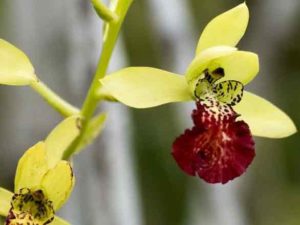 Beside the grasses and coffee plants, the orchids, with about one thousand registered species, belong to the biggest plant family of Madagascar. About 90% of the orchid species are endemic. Each of the different vegetation zones has its own species that can vary in their colour tones, sizes and ways of living. To help illustrate the diversity, we offer the following virtual journey to the most beautiful orchids of Madagascar. Let yourself be caught up by the attraction of the Hanitriniala, « the fragrance of the forest ».
Beside the grasses and coffee plants, the orchids, with about one thousand registered species, belong to the biggest plant family of Madagascar. About 90% of the orchid species are endemic. Each of the different vegetation zones has its own species that can vary in their colour tones, sizes and ways of living. To help illustrate the diversity, we offer the following virtual journey to the most beautiful orchids of Madagascar. Let yourself be caught up by the attraction of the Hanitriniala, « the fragrance of the forest ».
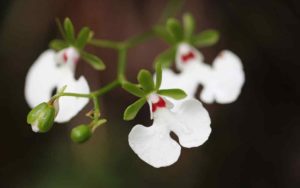 The endemic « star of Madagascar » belongs to the orchid species with big magnificent blossoms. It grows primarily in the woods of the sand coasts, both terrestrially and epiphytically. Its scientific name is Angraecum sesquipedale. The word sesquipedale means 1,5 feet referring to the spur of 45 cm length. In Darwin’s time, the procedure of pollination was not known. Darwin’s contemporaries doubted in his theory of a hawk moth with a snout 30 cm in length. However, the hawk moth was discovered after Darwin’s death: Xanthopan morgani praedicta.
The endemic « star of Madagascar » belongs to the orchid species with big magnificent blossoms. It grows primarily in the woods of the sand coasts, both terrestrially and epiphytically. Its scientific name is Angraecum sesquipedale. The word sesquipedale means 1,5 feet referring to the spur of 45 cm length. In Darwin’s time, the procedure of pollination was not known. Darwin’s contemporaries doubted in his theory of a hawk moth with a snout 30 cm in length. However, the hawk moth was discovered after Darwin’s death: Xanthopan morgani praedicta.
During the bloom from June to November, the pure white blossoms spread their delicate scent when darkness falls. The Angraecum sesquipedale often grows in the same region as Angraecum eburneum, another resident of the woods of the sand coasts, and prefers to stay local, which means it is strongly affected by the deforestation.
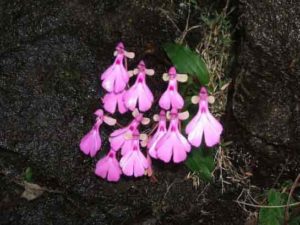 The Angraecum eburneum blooms in the dry period from July to September and in contrast to the Angraecum sesquipedale, it also blooms in houses when cultivated there. The Disperis, Calanthe and Cynorkis genera belong to the famous ground orchids. The genus Disperis includes delicate ground orchids that only reach 15 cm to 30 cm. There are about 22 species of this genus in Madagascar. Disperis literally means « two pockets », referring to the two opposing leaves. The colour of the blossom varies from white to pink and purple. The range of the genus Disperis reaches from Ambositra and Andringitra over the mountains of Tsaratanana to Sambirano.
The Angraecum eburneum blooms in the dry period from July to September and in contrast to the Angraecum sesquipedale, it also blooms in houses when cultivated there. The Disperis, Calanthe and Cynorkis genera belong to the famous ground orchids. The genus Disperis includes delicate ground orchids that only reach 15 cm to 30 cm. There are about 22 species of this genus in Madagascar. Disperis literally means « two pockets », referring to the two opposing leaves. The colour of the blossom varies from white to pink and purple. The range of the genus Disperis reaches from Ambositra and Andringitra over the mountains of Tsaratanana to Sambirano.
The most commonly occurring species are: Disperis trilineata, Disperis similis, Disperis tripetaloïdes, Disperis erucifera and Disperis hildebrantii. The Disperis similis genus can be found in the region of the central plateau, while the Disperis trilineata is more typically domestic in Northern Sambirano. The Disperis tripetaloïdes genus grows in the region of Bemaraha and Taolagnaro.
Some orchid species have adapted to their surroundings in such a way that they cannot survive outside their habitat. For example, the Solenangis aphylla species can only be found in the region of the coastal forest. This orchid, typically found in the dry forest, belongs to the aphyll species. The leafless orchid, with the small and nondescript blossoms, is characterised by a strongly developed root mass that undertakes the functions of both photosynthesis and nutrient intake.
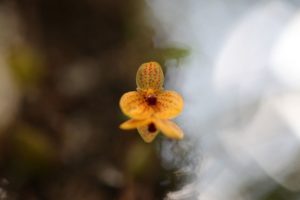
A lot of orchids are focused on their host plant. In the region with high precipitation of Maroantsetra, the orchid Eulophiella elisabethae grows on the palm Vohinitra utilis, and in the coastal forest of Palmarium in Akanin’ny Nofy, the species Cymbidiella humbloti grows in the leaf sheaths of the Raffia palm (Raphia ruffia). It is known as the « black orchid » due to its decorative beautiful blossoms. The question remains whether this association is due to symbiosis, or if the orchids could survive without their host plants.
The Cymbidiella flabellate species, which smells like vanilla, grows at the banks of the channel of Pangalane and in the heather of erica or phillipia.
The small island « Ile aux nattes”, on the southern tip of Sainte Marie is home to the queen of the orchids. The big orchid species, with its purple blossoms blooming in October, grows exclusively on the common screwpine (Pandanus utilis) and cannot survive in houses. Its florescence can reach more than 1 m. As its leaves are similar to the leaves of its host plant, the orchid only becomes visible when the large blossoms stand out against the leaves. If you are in Madagascar in October, you should not miss the chance to marvel at the most beautiful orchid of the island. The vanilla prospers both in the humid and dry regions of Madagascar. The best known species is the Vanilla planifolia. Nowhere else in the world is vanilla cultivated in such quantities as in the northeast coastal region of Madagascar: Sambava, Antalaha, Andapa and Vohemar. The wild vanilla « Vanilla decaryana » blooms in September in the Kirindy Forest.

